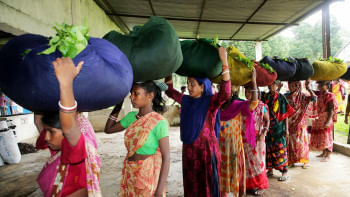Tannery industry: Does the 2024 proposed minimum wage meet expectations?

After several deferments, the Minimum Wage Board has finally proposed the new minimum wage for the Bangladeshi tannery industry. On September 9, 2024, the board issued a draft gazette proposing Tk 18,001 (for Savar and divisional areas) and Tk 17,048 (for other areas) as the new minimum wage for the tannery industry, effective from 2024 onwards. This proposed wage is approximately 34 percent higher than the existing minimum wage of Tk 13,500 for urban areas and Tk 12,800 for non-urban areas, which has been in place since 2018. The provision for a five percent annual wage increment (based on basic wage) is also set to continue.
The Minimum Wage Board deserves appreciation for proposing the wage within a short period since the formation of the interim government. There was an uncertainty whether the change in government would restart the whole wage-setting process. However, the process went through and after reviewing the feedback from the relevant stakeholders, we hope the new minimum wage would be finalised and implemented as quickly as possible. Any unnecessary delay would prolong workers' struggles to cope with the ongoing inflationary pressures.
The proposed wage amount is lower than Tk 18,378—which would have been the figure if only the inflation rate had been considered since 2018. The proposed wage falls short of the Tk 25,000 as well, the amount Tannery Workers Union (TWU) demands. It is also below Tk 22,776 that the Centre for Policy Dialogue proposed as the required minimum wage for tannery workers to maintain a basic standard of living, based on a recent empirical study. Hence, the wage board should consider further reviewing the proposed minimum wage amount and evaluate if increasing the amount is possible.
Consistency of grading practices
Unlike most other industries, one positive aspect of the tannery industry is its strong Collective Bargaining Agreement (CBA) practices. Over the years, wages have been determined through negotiations between workers and employers' representatives. CBA wages set over the last five years were found to be nominally higher than the government-set minimum wage. However, the wages for CBA are announced for a different grading structure (highly skilled, skilled, semi-skilled, and unskilled workers) compared to what is followed by the minimum wage board (grade 1 to grade 5). It creates confusion since some tanneries follow the government's grading system while others follow the CBA grading system, and some do not adhere to any grading system at all.
To ensure consistent grading practices across the industry, CPD proposed a unified grading system incorporating wage board and CBA-based grades into a single framework with five major grades (Grade 1 to Grade 5). Additionally, CPD suggested introducing sub-grades (Grade A, Grade B, Grade C, etc) within these main grades, allowing workers the opportunity for promotion to higher wage scales—a benefit not available under the current system, where workers remain in the same grade with no possibility of grade promotion. However, the draft gazette issued by the minimum wage board mentions a grading system similar to the one it has been following in the past, and no instruction on merging different grading systems is noticed.
Changes in the wage structure
The minimum wage structure proposed for the year 2024 remains largely unchanged compared to the year 2018. The wage structure consists of four components: basic allowance, housing allowance, medical allowance, and transport allowance. CPD recommended that housing allowances and other wage components be calculated as a percentage of the basic wage rather than remaining as fixed amounts. In line with CPD's recommendation, the housing allowance has been proposed at 70 percent of the basic wage (60 percent in non-divisional areas), which is a positive move. However, the health and transportation allowances remain fixed (Tk 1,100 and 700) for all categories of workers.
Given that CPD found educational costs have become a significant area of expenditure for tannery workers over the years, it proposed the inclusion of a new cost category, "Children's Education Allowance," in the wage structure. However, this has not been considered in the board's latest wage proposal.
Proper implementation of the new minimum wage needs extended attention. CPD's study indicated that the minimum wage adopted in 2018 was not widely implemented. Furthermore, 69 percent of the surveyed tanneries did not adhere to the official grade structure issued by the Minimum Wage Board.
In order to ensure the effective implementation of any newly proposed minimum wage in the tannery sector, the Department of Inspection for Factories and Establishments (DIFE) should conduct special inspections and produce progress reports within four months of the final approval of the new wage. There is a need to raise awareness among tannery workers who are primarily uninformed about government-set minimum wages. Additionally, mobile financial services (MFS) for wage transfers should be promoted to enhance accountability in wage disbursement.
Tamim Ahmed is senior research associate at the Centre for Policy Dialogue.
Dr Khondaker Golam Moazzem is research director at the Centre for Policy Dialogue.
Views expressed in this article are the author's own.
Follow The Daily Star Opinion on Facebook for the latest opinions, commentaries and analyses by experts and professionals. To contribute your article or letter to The Daily Star Opinion, see our guidelines for submission.

 For all latest news, follow The Daily Star's Google News channel.
For all latest news, follow The Daily Star's Google News channel. 










Comments